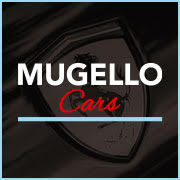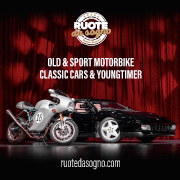Chassis No. ZFFMN34A0L0086620 Engine No. 23468 On 21 July 1987, the Maranello Civic Center swarming with the worldâs automotive press fell silent as an 89-year-old Enzo Ferrari shuffled to his position behind the speakersâ table. The event marked 40th anniversary of the first automobiles to carry his name, as well as the worldwide debut of what would become the final new model to be unveiled by âil Commendatoreâ before his passing in August 1988. âI expressed a wish to the engineers. Build a car to be the best in the world. And now the car is here,â stated Ferrari through a translator moments before a car cover was whisked away to reveal the brand-new Ferrari F40. What had been spotted on the Fiorano test track and speculated to be the 288 GTOâs successor in the months leading up to its public unveiling was in fact the 288 Evoluzione â a limited prototype that acted as a testbed for the 40th anniversary model. The true shape of the F40 was more purposeful than the multi-slotted prototype, with Pininfarina sculpting a low, aggressive nose and an astonishingly wide rear deck dominated by an integral wing. Save for its cabin section and windshield which it shared with its 328 GTB/GTS contemporaries, the radical shape was entirely new, as were its Kevlar and carbon fiber construction materials. The story was much the same beneath the skin, with its tubular steel chassis supplemented by composite materials forming the sill box sections, cabin floor pan, and front bulkhead. The F40 was the first road car to use these innovative lightweight materials to such a degree, resulting in a scant 2,425-pound curb weight. No less than eleven horizontal vents in the rear Plexiglas screen offered a glimpse of the engine bay. While the F40âs 90-degree, twin-turbocharged âF120Aâ V8 was similar in general configuration to that of the 288 GTO, a number of developments pioneered on the 288 Evoluzione saw a substantial increase in performance figures. A small bump in displacement from 2,855 cc to 2,936 cc, a higher compression ratio up from 7.6:1 to 7.7:1, a rise in boost pressure from 0.8 to 1.1 bar, and other nominal improvements raised peak power output to 478 horsepower and 425 lb-ft of torque. Paired with the same five-speed all-synchromesh transmission in the 288 GTO with altered gearing, the F40 was, at launch, the fastest production car in the world with a claimed top speed of 201 miles per hour. Initially, Ferrari refused to disclose how many F40s would be built and over what period so as to avoid a repeat of the spiraling secondary market of the 288 GTO. Ultimately, 1,311 production examples were built, with a mere 213 F40s destined for the United States. Nearing the middle of F40 production, chassis number 86620 was completed in August 1990 as a 1990 model yearâone of approximately 90 U.S.-market examples delivered that year. Originally delivered through Shelton Ferrari of Fort Lauderdale, the significant Ferrari was driven modestly by its original owner, accumulating just 735 by the summer of 1992 when it was offered for sale by European Auto Sales in Costa Mesa, California. In December 1992, with just 771 miles recorded, the F40 passed into the hands of a noted Southern California collector. Over his two-decade stewardship lasting until 2012, the Ferrari was maintained in exceptional condition while adding a mere 221 miles to its odometer. Joining a new private collection in October 2012, the F40 reportedly underwent a comprehensive 1,000-mile service performed by Ferrari Factory Certified Technician John Tirell of Independent Ferrari Specialists at a cost exceeding $18,000. The accompanying CARFAX Vehicle History report notes that the car was subsequently exported from New Jersey to the United Arab Emirates in January 2013, where it was displayed on loan in "The Art of Ferrari" exhibition in Galleria Ferrari at Ferrari World Abu Dhabi, remaining there until July 2014. Upon its return to the United States, still showing just 1,003 miles, the F40 was sent directly to Ferrari of Atlanta. There, it received new tires and underwent thorough servicing and inspection, including the completion of a Ferrari Classiche certification application. Its Classiche âRed Book,â issued in February 2015, notes that the car retains its matching-numbers Tipo F102D engine and Tipo F120DB transmission, original body, and original chassis. Prior to entering the current Florida-based collection in 2023, the Ferrari was reportedly treated to a major service performed by Ferrari of Los Angeles. Chassis 86620 now shows just 1,248 miles since new and maintains an extraordinary degree of originality and factory correctness, which received impressive validation when it earned a Platinum award against strong competition at the FCA Annual Meet in Elkhart Lake, Wisconsin, in September 2024. The exterior is resplendent in its factory Rosso Corsa finish, adorned with enamel Scuderia Ferrari shields on the front fenders, rectangular âDisegno di Pininfarinaâ badges on the rear quarter panels, and the Ferrari script on the engine cover. Inside, the sparse interior features Stoffa Vigogna upholstery trimming the Kevlar shell bucket seats, complemented by a three-spoke MOMO steering wheel and a chromed open-gate five-speed shifter. Ferraristi seeking to acquire a cherished and extensively documented example of the legendary F40âa critical component of the so-called âBig Fiveâ Ferrari supercar lineageâwill seldom find a better opportunity than chassis 86620. This outstanding Classiche-certified Ferrari, with its low mileage and original accessories including its manuals and tool roll, is sure to captivate collectors of Maranelloâs groundbreaking supercars, offering immeasurable joy whether showcased at FCA events or unleashed on the open road for its thrilling performance.
- Fuel
- Body Types
- Transmission
- Exterior Colour
- Number of doors
- Interior Colour
- VIN CodeZFFMN34A0L0086620


































































































